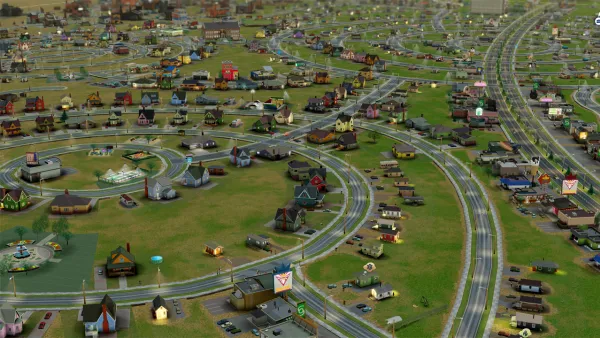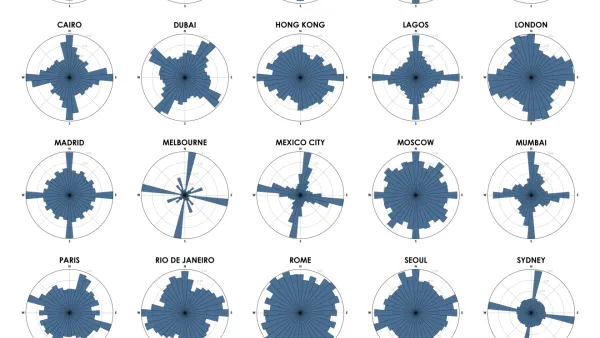Smart growth supporters tend to prefer grid systems to cul-de-sacs, for excellent reasons. A proliferation of cul-de-sacs artificially lengthens walking distances: if streets don’t connect to each other, you might have to walk a mile to go just a few hundred feet. In addition, cul-de-sacs increase traffic congestion by dumping most vehicular traffic on a few major streets. And because biking is less safe on busy, high-traffic streets, bikers benefit from a grid system as well.
Smart growth supporters tend to prefer grid systems to cul-de-sacs, for excellent reasons. A proliferation of cul-de-sacs artificially lengthens walking distances: if streets don't connect to each other, you might have to walk a mile to go just a few hundred feet. In addition, cul-de-sacs increase traffic congestion by dumping most vehicular traffic on a few major streets. And because biking is less safe on busy, high-traffic streets, bikers benefit from a grid system as well.
But banning cul-de-sacs on residential streets might go too far: many homeowners understandably prefer cul-de-sacs because of the absence of "cut through traffic" on those streets (that is, traffic cutting through from one major street to another). Is there a middle ground between current subdivision ordinances (which sometimes require new subdivisions to be dominated by cul-de-sacs) and wiping out cul-de-sacs altogether?
One option might be for government to neither encourage nor discourage cul-de-sacs. It seems to me that this result would clearly be preferable to the status quo, as it maximizes consumer choice while reducing at least some of the social harms caused by cul-de-sacs.
On the other hand, one common justification for government regulation is to prevent situations where it makes sense for individuals to do X, but if lots of individuals do X, we all lose something. It could legitimately be argued that the prevalence of cul-de-sacs may be such a situation: if I live on the only cul-de-sac in the neighborhood, I have less traffic on my street (presumably a good thing) but still live in a basically walkable and uncongested neighborhood. But if everyone else lives on a cul-de-sacs, I have to suffer through all the disadvantages of cul-de-sacs as well: more traffic congestion because everyone has to drive on a couple of main streets, and reduced walkability as distances between houses multiply.
A second "middle ground" alternative is to allow cul-de-sacs in new subdivisions, but to create a quota limiting their number- for example, to provide that there be no more than one cul-de-sac for every intersection.This rule might accommodate consumer demand for cul-de-sacs, but would ensure that there were enough interconnected streets to accommodate driving, walking and biking.
A third compromise is the "fused grid." Under a fused grid street system, there is a grid of main streets and a set of cul-de-sacs branching off from those streets. But the difference between the fused grid and a cul-de-sac system is as follows: in the latter situation, there is nothing to connect one cul-de-sac to another, so walkers and bikers have to travel out of their way to reach other cul-de-sacs. By contrast, a fused grid "fuses" the cul-de-sacs with miniature parks or pathways designed for bicycles and pedestrians, thus allowing nondrivers to go from one house to another. When streets in an existing grid network are closed off to cars, something similar to a fused grid is created: cars are limited as in a cul-de-sac system, while pedestrians are as mobile as in a grid system.

Analysis: Cybertruck Fatality Rate Far Exceeds That of Ford Pinto
The Tesla Cybertruck was recalled seven times last year.

National Parks Layoffs Will Cause Communities to Lose Billions
Thousands of essential park workers were laid off this week, just before the busy spring break season.

Retro-silient?: America’s First “Eco-burb,” The Woodlands Turns 50
A master-planned community north of Houston offers lessons on green infrastructure and resilient design, but falls short of its founder’s lofty affordability and walkability goals.

Test News Post 1
This is a summary

Analysis: Cybertruck Fatality Rate Far Exceeds That of Ford Pinto
The Tesla Cybertruck was recalled seven times last year.

Test News Headline 46
Test for the image on the front page.
Urban Design for Planners 1: Software Tools
This six-course series explores essential urban design concepts using open source software and equips planners with the tools they need to participate fully in the urban design process.
Planning for Universal Design
Learn the tools for implementing Universal Design in planning regulations.
EMC Planning Group, Inc.
Planetizen
Planetizen
Mpact (formerly Rail~Volution)
Great Falls Development Authority, Inc.
HUDs Office of Policy Development and Research
NYU Wagner Graduate School of Public Service





























